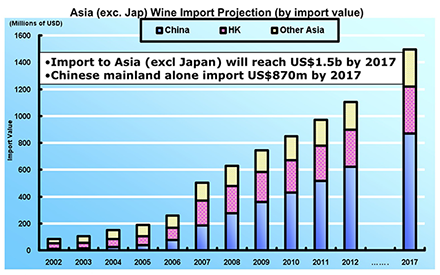Hong Kong Wants More U.S. Wine
U.S. imports grew 98% in one year to tax-free destination

By volume, the total increased by 76% from 2004 to 2008, when it reached 2.25 million cases. The volume is forecasted to be 4.8 million cases in 2013. The increase is largely due to the region’s elimination of a 40% excise tax on wine in 2008. The 7 million-person area is one of the few places in the world with no taxes on alcoholic beverages.
By contrast, the tax on wine imported into mainland China includes a 14% import tax, 17% value-added tax and 10% consumption tax. In Thailand, the tax is 200%.
Neither are there any labeling requirements for wine in Hong Kong, and most businesspeople in Hong Kong speak English in addition to Chinese. In China, the label must include these items (in Chinese):
• Name or brand of wine
• Ingredients
• Net content (ml)
• Alcoholic content (percent)
• Production date (yy/mm/dd)
• Packer (name and address)
• Distributor (name and address)
• Importer (name and address)
• Country of origin
• Quality guarantee and/or storage period (yy/mm/dd)
• Sugar content (gram/I)
Interestingly, 81% of the wine imported into Hong Kong is consumed locally. The remainder is exported, including to mainland China (Hong Kong is largely an island).
Yet total wine imports to Hong Kong were an astonishing $464 million, so there’s plenty of room for American companies to expand their export markets. France and Australia are now the biggest players, with France providing 50% of the total.
Individual wine consumption was 3.6 liters per capita in 2009, higher than other Asian regions including mainland China, Japan, South Korea and Singapore. Local consumers in Hong Kong overwhelmingly prefer red wine, which constituted 94.5% of total wine imports.
Hong Kong has become the gateway to China, and the local government is encouraging this position by negotiating easy entry and other advantages. One result: While the region once derived 85% of its income from manufacturing, that total is now only 10%.
Both the Hong Kong and U.S. governments are taking many steps to encourage the exports. Three years ago, the semi-governmental Hong Kong Trade Development Council established the first Hong Kong International Wine & Spirits Fair. The third will be held Nov. 4-6.
Last’s year’s show attracted 525 exhibitors from 34 countries and regions, as well as 11,915 buyers from 62 countries and regions. It also drew 12,000 consumers at designated times.
Only 25 exhibitors were from the U.S., which did not mount an inclusive national exhibit as did other countries, including small nations like Croatia and Slovenia.
The U.S. exhibitors included five pioneering members of the Family Winemakers of California
. President Paul Kronenberg spoke about their experience at a promotional presentation arranged by the Hong Kong Trade Development Council. He said attendees at the show showed “positive curiosity” about American wines but didn’t know much about them.
“You’ll have to invest time -- and I mean a few years -- in educating them if you want to succeed,” he said. “It will take a lot of education.”
Kronenberg added that the greatest interest seemed to be in bottles selling for $8 to $12 retail, although many companies sought wines at $1 per bottle.
Hong Kong is also the world’s second-largest wine auction market, just surpassing London, so buyers there are also interested in expensive wines.
Kronenberg reported that the people at the show were more interested in looking than tasting: The look of the bottle is important, he said. “Dark bottles with red and gold were most popular. Art wasn’t of much interest.”
He summarized, “The wineries that attended didn’t do a lot of business, but they made many contacts they think will prove valuable.”
Exporter Brix22 represented 19 wineries at last year’s conference, and after a follow-up visit, placed eight within eight months, said director of operations Olivia Lizotte. “You need face-time in Hong Kong.”
Dannie Chin from the HKTDC noted that a group of 10 Virginia wineries has already signed up for this year’s show, in a good-natured challenge to guests at the Napa event, where the council hoped to recruit more exhibitors.
For first-time exhibitors, the cost is $2,578.50 for a 4.5 square meter (about 50 square foot) booth or $5,157 for a 9 square meter booth, with a 5% early bird discount if the application is received by Aug. 31.
Three nights’ rooming will be included for the first 10 applicants, and for groups like regional associations, one round-trip economy class air ticket to/from Hong Kong plus three nights’ free hotel accommodation, if 10 or more companies are recruited by the trade organization.
The group has also arranged a four-day/three-night travel package on Cathay Pacific economy air, plus three nights’ hotel accommodation, for about $1,200.
A consumer wine festival is planned one week before the trade fair: Wineries can add that for $700. Last year’s festival attracted attendance of 70,000.
The U.S. government also has many programs to encourage exports, including rebates of half the costs to attend trade shows through the Western United States Agricultural Trade Association (WUSATA), and many programs from the U.S. Commercial Service, part of the Department of Commerce, U.S. Department of Agriculture and the Export-Import Bank, which provides insurance for sales.
Get more information at hktdc.com. The primary contact for the trade fair is marketing manager Julia Son at (213) 622-3194, ext. 215, or julia.h.son@hktdc.org.